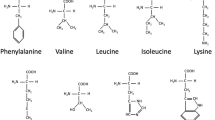Abstract
This study reports the association of five blood types, three enzymes, two proteins, Escherichia coli F18 receptor gene (ECF18R), and the Ryanodin receptor (RYR1) gene with six production traits, four meat quality traits, and two osteochondral diseases in Swiss pig populations. Data on on-farm traits (daily weight gain, percent premium cuts, and backfat) and on station-tested traits (daily weight gain, feed conversion ratio, meat quality, and osteochondral lesions) were available on 3,918 and 303 animals, respectively. A mixed linear model with allele substitution effects was used for each trait by marker analysis (144 analyses). Significant marker-trait associations and allele substitution effects are presented. In general, heritability estimates for production and meat quality traits were higher than those for osteochondral lesions. Blood types lack significant associations with many traits except H and S types. Enzymes (mainly, glucose phosphate isomerase) and protein polymorphisms show significant associations with daily weight gain, premium cuts, and backfat as well as osteochondral lesions. The RYR and ECF18R genes significantly affected all growth, production, and lean meat content traits and osteochondral lesions; RYR also affected pH values. This study reports many novel marker-trait associations, particularly between the incidence of osteochondral lesions and polymorphisms at glucose phosphate isomerase, 6-phosphogluconate dehydrogenase, postalbumin 1A, RYR, and ECF18R loci. These results should be useful in selection and for further functional genomics and proteomics investigations.

Similar content being viewed by others
References
Fujii J, Otsu K, Zorzato f, Deleon S, Khanna VK, Weiler JE, Obrien PJ, Maclennan DH (1991) Identification of a mutation in porcine ryanodine receptor associated with malignant hyperthermia. Science 253:448–451
Gilmour AR, Gogel BJ, Cullis BR, Welham SJ, Thompson R (2002) ASReml User Guide Release 1.0. VSN International Ltd., Hemel Hempstead, UK
Hermesch S, Luxford BG, Graser HU (2000) Genetic parameters for lean meat yield, meat quality, reproduction and feed efficiency traits for Australian pigs: 1. Description of traits and heritability estimates. Livest Prod Sci 65:239–248
Houde A, Pommier SA, Roy R (1993) Detection of the ryanodine receptor mutation associated with malignant hyperthermia in purebred swine populations. J Anim Sci 71:1414–1418
Hu ZL, Dracheva S, Jang W, Maglott D, Bastiaansen J, Rothschild MF, Reecy JM (2005) A QTL resource comparison tool for pigs: PigQTLDB. Mamm Genome 15:792–800
Jørgensen B (1995) Effect of different energy and protein levels on leg weakness and osteochondrosis in pigs. Livest Prod Sci 41:171–181
Kadarmideen HN, Janss LLG (2005) Evidence of major gene for osteochondral disease in pigs from a bayesian segregation analysis. Genetics 171:1195–1206
Kadarmideen HN, Janss LLG (2007) Population and systems genetics analyses of cortisol in pigs divergently selected for stress. Physiol Genomics 29:57–65
Kadarmideen HN, Janss LLG, Dekkers JCM (2000) Power of quantitative trait locus mapping for polygenic binary traits using generalized and regression interval mapping in multi-family half-sib designs. Genet Res 76:305–317
Kadarmideen HN, Rekaya R, Gianola D (2001) Genetic parameters for clinical mastitis in Holstein-Friesians: a bayesian analysis. Anim Sci 73:229–240
Kadarmideen HN, Schwörer D, Ilahi H, Malek M, Hofer A (2004) Genetics of osteochondral disease and its relationship with meat quality and quantity, growth and feed conversion traits in pigs. J Anim Sci 82:3118–3127
Kadarmideen HN, Von Rohr P, Janss LLG (2006) From genetical-genomics to systems genetics: potential applications in quantitative genomics and animal breeding. Mamm Genome 17:548–564
Lahucky R, Christian LL, Kovac L, Stalder KJ, Bauerova M (1997) Meat quality assessed ante- and post mortem by different ryanodine receptor gene status of pigs. Meat Sci 47:277–285
Larzul C, LeRoy P, Gueblez R, Talmant A, Gogue J, Sellier P, Monin G (1997) Effect of halothane genotype (NN, Nn, nn) on growth, carcass and meat quality traits of pigs slaughtered at 95 kg or 125 kg live weight. J Anim Breed Genet 114:309–320
Lundeheim N (1987) Genetic analysis of osteochondrosis and leg weakness in the Swedish pig progeny testing scheme. Acta Agric Scand 37:159–173
Meijerink E, Fries R, Vogeli P, Masabanda J, Wigger G, Stricker C, Neuenschwander S, Bertschinger HU, Stranzinger G (1997) Two alpha(1,2) fucosyltransferase genes on porcine chromosome 6q11 are closely linked to the blood group inhibitor (S) and Escherichia coli F18 receptor (ECF18R) loci. Mamm Genome 8:736–741
Murray AC, Johnson CP (1998) Impact of the halothane gene on muscle quality and pre-slaughter deaths in western Canadian pigs. Canadian J Anim Sci 78:543–548
Otsu K, Khanna VK, Archibald AL, Maclennan DH (1991) Cosegregation of porcine malignant hyperthermia and a probable causal mutation in the skeletal-muscle ryanodine receptor gene in backcross families. Genomics 11:744–750
Rothschild MF, Christian LL, Jung YC (1988) Genetic control of front-leg weakness in Duroc swine. II. Correlated responses in growth rate, backfat and reproduction from five generations of divergent selection. Livest Prod Sci 19:473–485
Sharif S, Mallard BA, Wilkie BN, Sargeant JM, Scott HM, Dekkers JCM, Leslie KE (1998) Associations of the bovine major histocompatibility complex DRB3 (BoLA-DRB3) alleles with occurrence of disease and milk somatic cell score in Canadian dairy cattle. Anim Genet 29:185–193
Vögeli P, Bolt R, Fries R, Stranzinger G (1994) Co-segregation of the malignant hyperthermia and the arg(615)-cys(615) mutation in the skeletal-muscle calcium-release channel protein in 5 European landrace and pietrain pig breeds. Anim Genet 25(Suppl 1):59–66
Vögeli P, Bertschinger HU, Stamm M, Stricker C, Hagger C, Fries R, Rapacz J, Stranzinger G (1996) Genes specifying receptors for F18 fimbriated Escherichia coli, causing oedema disease and postweaning diarrhoea in pigs, map to chromosome 6. Anim Genet 27:321–328
Zhang W, Kuhlers DL, Rempel E (1992) Halothane gene and swine performance. J Anim Sci 70:1307–1313
Acknowledgments
The author thanks the SuisAG company for provision of trait data and Dr. Peter Vögeli at ETH Zurich, Switzerland, for geno- and phenotyping and for useful discussions.
Author information
Authors and Affiliations
Corresponding author
Rights and permissions
About this article
Cite this article
Kadarmideen, H.N. Biochemical, ECF18R, and RYR1 Gene Polymorphisms and Their Associations with Osteochondral Diseases and Production Traits in Pigs. Biochem Genet 46, 41–53 (2008). https://doi.org/10.1007/s10528-007-9127-5
Received:
Accepted:
Published:
Issue Date:
DOI: https://doi.org/10.1007/s10528-007-9127-5




